Optimal Insertion of Energy Storage Systems Considering the Economic Dispatch and the Minimization of Energy Not Supplied
Abstract
:1. Introduction
- Reduce operating costs due to the state of charge of the batteries as a storage medium.
- Plan possible expansions in the electrical transmission system by redirecting power flows, through the contribution of energy storage systems.
- Increase firmness in delivering non-conventional renewable energy whose resource is intermittent.
- Minimize the income from the dispatch of thermoelectric generation in hours when the energy cost is high, and prioritize the entry of energy storage systems.
- Mitigate the effect of the emission of polluting gases by reducing plants that demand fossil fuel resources, replacing them with clean energy storage and generation through renewable energies.
2. Materials and Methods
- (1)
- Non-linear for the AC flow equations and a mixed integer for the selection and investment decision variables.
- (2)
- Linear by the DC flow equations and mixed integer by the selection and investment decision variables [43].
| Generation plants | |
| Conventional generation (thermal and hydro) | |
| Non-conventional generation (wind and solar) | |
| Time horizon temporal of analysis | |
| Bar or network connection nodes | |
| The unit cost of generation per generating plant | |
| Power of each generating plant per hour | |
| Unserved energy cost per unit | |
| Load not served per bar in each hour | |
| Battery charging power per bar per hour | |
| Battery discharge power per bar per hour | |
| Valued price of the charge | |
| Valued price of the discharge |
| The minimum power of each generator | |
| Maximum power of each generator | |
| Resource occurrence per generator per hour |
| Start ramp for power delivery per generator per hour | |
| Stop ramp from absorbing energy per generator per hour. |
| One-day analysis period (24 h) | |
| Capacity utilization factor of each generator |
| corresponding to a respective hour | |
| end bar as a function of time |
| Active power limit for energy transfer through transmission lines |
| BESS state of charge per bar per hour | |
| The initial state of charge of each BESS per bar per hour | |
| BESS charge efficiency | |
| BESS discharge efficiency |
| Maximum BESS state of charge | |
| Maximum percentage discharge of the BESS | |
| Maximum percentage charge of the BESS | |
| Minimum percentage of the state of charge | |
| Decision variable for choosing the BESS |
| Total BESS units to be incorporated |
- (1)
- This first study is considered the base case, and it analyzes power dispatch, the charge flows of the lines, and the resulting costs without batteries as a means of storage. The demand–supply is evaluated at the energy level, and from the electrical point of view, the resulting variables are evaluated when demand is at its maximum.
- (2)
- For this study, the optimization model incorporating the BESS is applied, and the power dispatch, the charge flows of the lines, and resulting costs are also analyzed. The energy and electrical level evaluation is similar to the base case, but the effects of storage systems are also considered.
3. Results
- i.
- Base Case: IEEE 24-bus system without BESS
- ii.
- Optimal location of the BESS in the IEEE 24-bar systems
4. Discussion
5. Conclusions
Author Contributions
Funding
Conflicts of Interest
References
- Liu, Z.; Liu, Y.; Xu, H.; Liao, S.; Zhu, K.; Jiang, X. Dynamic economic dispatch of power system based on DDPG algorithm. Energy Rep. 2022, 8, 1122–1129. [Google Scholar] [CrossRef]
- Téllez, A.A.; Ortiz, L.; Ruiz, M.; Narayanan, K.; Varela, S. Optimal location of reclosers in electrical distribution systems considering multicriteria decision through the generation of scenarios using the Montecarlo method. In Proceedings of the 2015 IEEE 6th Latin American Symposium on Circuits & Systems (LASCAS 2015), Montevideo, Uruguay, 24–27 February 2015. [Google Scholar] [CrossRef]
- Abdin, A.F.; Zio, E. Optimal Planning of Electric Power Systems. Springer Optim. Appl. 2019, 152, 53–65. [Google Scholar]
- Yang, Y.; Wu, W.; Wang, B. Adjustable Robust Economic Dispatch: Case Study on its Application and Evaluation in Power System. In Proceedings of the 2020 IEEE 4th Conference on Energy Internet and Energy System Integration (EI2), Wuhan, China, 30 October–1 November 2020; pp. 1439–1443. [Google Scholar] [CrossRef]
- Ubertalli, J.; Littler, T. Chapter 4Proven energy storage system applications for power systems stability and transition issues. In Predictive Modelling for Energy Management and Power Systems Engineering; Deo, R., Samui, P., Roy, S.S., Eds.; Elsevier: Amsterdam, The Netherlands, 2021; pp. 85–114. [Google Scholar] [CrossRef]
- Castillo, F.; Aguila, A.; Gonzalez, J. Analysis of Stability of Tension and Losses of Electric Power in Distribution Networks with Distributed Generation. IEEE Lat. Am. Trans. 2016, 14, 4491–4498. [Google Scholar] [CrossRef]
- Tellez, A.A.; Galarza, D.F.C.; Matos, L.O. Analysis of power losses in the asymmetric construction of electric distribution systems. IEEE Lat. Am. Trans. 2015, 13, 2190–2194. [Google Scholar] [CrossRef]
- Aguila, A.; Wilson, J. Technical and Economic Assessment of the Implementation of Measures for Reducing Energy Losses in Distribution Systems. IOP Conf. Series: Earth Environ. Sci. 2017, 73, 12018. [Google Scholar] [CrossRef] [Green Version]
- López-Grajales, A.M.; González-Sanchez, J.W.; Cardona-Restrepo, H.A.; Isaac-Millan, I.A.; López-Jiménez, G.J.; Vasco-Echeverri, O.H. Economy, financial, and regulatory method for the integration of electrical energy storage in a power network. J. Energy Storage 2023, 58, 106433. [Google Scholar] [CrossRef]
- Zhang, Z.; Ding, T.; Zhou, Q.; Sun, Y.; Qu, M.; Zeng, Z.; Ju, Y.; Li, L.; Wang, K.; Chi, F. A review of technologies and applications on versatile energy storage systems. Renew. Sustain. Energy Rev. 2021, 148, 111263. [Google Scholar] [CrossRef]
- Koohi-Fayegh, S.; Rosen, M.A. A review of energy storage types, applications and recent developments. J. Energy Storage 2020, 27, 101047. [Google Scholar] [CrossRef]
- Mitali, J.; Dhinakaran, S.; Mohamad, A. Energy storage systems: A review. Energy Storage Sav. 2022, 1, 166–216. [Google Scholar] [CrossRef]
- Wang, J.; Deng, H.; Qi, X. Cost-based site and capacity optimization of multi-energy storage system in the regional integrated energy networks. Energy 2022, 261, 125240. [Google Scholar] [CrossRef]
- Garrido, C.; Téllez, A.A.; Ortiz, L. Linear Voltage Stability Indicator (LVSI) for Optimal Placement of SVC Devices to Improve the Voltage Stability Margin in Transmission Systems. Electronics 2022, 12, 43. [Google Scholar] [CrossRef]
- Razzhivin, I.; Suvorov, A.; Ufa, R.; Andreev, M.; Askarov, A. The energy storage mathematical models for simulation and comprehensive analysis of power system dynamics: A review. Part II. Int. J. Hydrogen Energy 2023, 48, 6034–6055. [Google Scholar] [CrossRef]
- Valencia, A.; Hincapie, R.A.; Gallego, R.A. Optimal location, selection, and operation of battery energy storage systems and renewable distributed generation in medium–low voltage distribution networks. J. Energy Storage 2020, 34, 102158. [Google Scholar] [CrossRef]
- Sok, V.; Tayjasanant, T. Determination of optimal siting and sizing of energy storage system in PV-connected distribution systems considering minimum energy losses. In Proceedings of the 2017 14th International Conference on Electrical Engineering/Electronics, Computer, Telecommunications and Information Technology (ECTI-CON), Phuket, Thailand, 27–30 June 2017; pp. 451–454. [Google Scholar]
- Saha, S.; Saini, G.; Mishra, S.; Chauhan, A.; Upadhyay, S. A comprehensive review of techno-socio-enviro-economic parameters, storage technologies, sizing methods and control management for integrated renewable energy system. Sustain. Energy Technol. Assessments 2022, 54, 102849. [Google Scholar] [CrossRef]
- Alsharif, H.; Jalili, M.; Hasan, K.N. Power system frequency stability using optimal sizing and placement of Battery Energy Storage System under uncertainty. J. Energy Storage 2022, 50, 104610. [Google Scholar] [CrossRef]
- Furtado, G.C.D.A.; Mesquita, A.L.A.; Morabito, A.; Hendrick, P.; Hunt, J.D. Using hydropower waterway locks for energy storage and renewable energies integration. Appl. Energy 2020, 275, 115361. [Google Scholar] [CrossRef]
- de Luis-Ruiz, J.M.; Carcedo-Haya, J.; Pereda-García, R.; Castro-Alonso, P.; Pérez-Álvarez, R. Optimal location of hydraulic energy storage using geographic information systems and multi-criteria analysis. J. Energy Storage 2022, 49, 104159. [Google Scholar] [CrossRef]
- Nikolaou, T.; Stavrakakis, G.S.; Tsamoudalis, K. Modeling and Optimal Dimensioning of a Pumped Hydro Energy Storage System for the Exploitation of the Rejected Wind Energy in the Non-Interconnected Electrical Power System of the Crete Island, Greece. Energies 2020, 13, 2705. [Google Scholar] [CrossRef]
- Wali, S.B.; Hannan, M.A.; Reza, M.S.; Ker, P.J.; Begum, R.A.; Rahman, M.S.A.; Mansor, M. Battery storage systems integrated renewable energy sources: A biblio metric analysis towards future directions. J. Energy Storage 2021, 35, 102296. [Google Scholar] [CrossRef]
- Jafari, M.; Korpås, M.; Botterud, A. Power system decarbonization: Impacts of energy storage duration and interannual renewables variability. Renew. Energy 2020, 156, 1171–1185. [Google Scholar] [CrossRef]
- Challenge, E.S.G. Energy Storage Market Report; US Department of Energy: Washington, DC, USA, 2020. [Google Scholar]
- Hannan, M.; Wali, S.; Ker, P.; Rahman, M.A.; Mansor, M.; Ramachandaramurthy, V.; Muttaqi, K.; Mahlia, T.; Dong, Z. Battery energy-storage system: A review of technologies, optimization objectives, constraints, approaches, and outstanding issues. J. Energy Storage 2021, 42, 103023. [Google Scholar] [CrossRef]
- Lai, C.S.; Locatelli, G. Economic and financial appraisal of novel large-scale energy storage technologies. Energy 2021, 214, 118954. [Google Scholar] [CrossRef]
- Téllez, A.; López, G.; Isaac, I.; González, J. Optimal reactive power compensation in electrical distribution systems with distributed resources. Review. Heliyon 2018, 4, e00746. [Google Scholar] [CrossRef] [PubMed] [Green Version]
- Téllez, A.A. Optimización Multicriterio de Flujos de Potencia Reactiva en Sistemas Eléctricos de Distribución. Tesis de Doctorado. 15 June 2021, p. 105. Available online: http://hdl.handle.net/20.500.11912/8699 (accessed on 1 June 2021).
- Águila, A.; Ortiz, L.; Orizondo, R.; López, G. Optimal location and dimensioning of capacitors in microgrids using a multicriteria decision algorithm. Heliyon 2021, 7, e08061. [Google Scholar] [CrossRef]
- Olabi, A.; Onumaegbu, C.; Wilberforce, T.; Ramadan, M.; Abdelkareem, M.A.; Alami, A.H.A. Critical review of energy storage systems. Energy 2021, 214, 118987. [Google Scholar] [CrossRef]
- Torabi, F.; Ahmadi, P. Chapter 1—Battery technologies. In Simulation of Battery Systems; Torabi, F., Ahmadi, P., Eds.; Academic Press: Cambridge, MA, USA, 2020; pp. 1–54. [Google Scholar]
- Ckardt, G.S.; Pistonesi, H. A Possibilistic Model to Sstimate the Intrinsic Cost of Non Supply Energy in Electric Distribution Systems. Argentina. 2012. Available online: http://www.scielo.org.co/scielo.php?pid=S0012-73532010000200026&script=sci_abstract&tlng=en (accessed on 1 June 2021).
- RMER and CRIE. Metodología Para el Cálculo del Costo de Energía No Suministrada—CRIE. 2013. Available online: https://crie.org.gt/wp/wp-content/uploads/2018/01/METODOLOG%C3%8DA-PARA-EL-C%C3%81LCULO-DEL-COSTO-DE-LA-ENERG%C3%8DA-NO-SUMINISTRADA.pdf (accessed on 1 June 2021).
- Hamidan, M.-A.; Borousan, F. Optimal planning of distributed generation and battery energy storage systems simultaneously in distribution networks for loss reduction and reliability improvement. J. Energy Storage 2021, 46, 103844. [Google Scholar] [CrossRef]
- Nie, B.; Palacios, A.; Zou, B.; Liu, J.; Zhang, T.; Li, Y. Review on phase change materials for cold thermal energy storage applications. Renew. Sustain. Energy Rev. 2020, 134, 110340. [Google Scholar] [CrossRef]
- Kim, R.-K.; Glick, M.B.; Olson, K.R.; Kim, Y.-S. MILP-PSO Combined Optimization Algorithm for an Islanded Microgrid Scheduling with Detailed Battery ESS Efficiency Model and Policy Considerations. Energies 2020, 13, 1898. [Google Scholar] [CrossRef] [Green Version]
- Yang, Y.; Bremner, S.; Menictas, C.; Kay, M. Modelling and optimal energy management for battery energy storage systems in renewable energy systems: A review. Renew. Sustain. Energy Rev. 2022, 167, 112671. [Google Scholar] [CrossRef]
- Lipu, M.H.; Ansari, S.; Miah, S.; Hasan, K.; Meraj, S.T.; Faisal, M.; Jamal, T.; Ali, S.H.; Hussain, A.; Muttaqi, K.M.; et al. A review of controllers and optimizations based scheduling operation for battery energy storage system towards decarbonization in microgrid: Challenges and future directions. J. Clean. Prod. 2022, 360, 132188. [Google Scholar] [CrossRef]
- Kantor, I.; Robineau, J.-L.; Bütün, H.; Marechal, F. A mixed-integer linear programming formulation for optimizing multi-scale material and energy integration. Front. Energy Res. 2020, 8, 49. [Google Scholar] [CrossRef] [Green Version]
- Varetsky, Y.; Konoval, V.; Seheda, M. Modeling Power Flow within a Microgrid for Energy Storage Sizing. In Proceedings of the 2020 IEEE 7th International Conference on Energy Smart Systems (ESS), Kyiv, Ukraine, 12–14 May 2020; pp. 150–153. [Google Scholar] [CrossRef]
- Shah, C.; Wies, R. Algorithms for Optimal Power Flow in Isolated Distribution Networks Using Different Battery Energy Storage Models. In Proceedings of the 2020 IEEE Power & Energy Society Innovative Smart Grid Technologies Conference (ISGT), Washington, DC, USA, 17–20 February 2020; pp. 1–5. [Google Scholar] [CrossRef]
- Mühlbauer, M.; Bohlen, O.; Danzer, M.A. Analysis of power flow control strategies in heterogeneous battery energy storage systems. J. Energy Storage 2020, 30, 101415. [Google Scholar] [CrossRef]
- Ordoudis, C.; Pinson, P.; Morales, J.; Zugno, M. An Updated Version of the IEEE RTS 24-Bus System for Electricity Market and Power System Operation Studie; Technical University of Denmark: Kongens Lyngby, Denmark, 2016; Volume 13. [Google Scholar]
- van der Veen, R.A.; Hakvoort, R.A. The electricity balancing market: Exploring the design challenge. Util. Policy 2016, 43, 186–194. [Google Scholar] [CrossRef] [Green Version]
- Hosseinzadeh, A.; Zhou, J.L.; Li, X.; Afsari, M.; Altaee, A. Techno-economic and environmental impact assessment of hydrogen production processes using bio-waste as renewable energy resource. Renew. Sustain. Energy Rev. 2022, 156. [Google Scholar] [CrossRef]
- El-Enien, A.S.A. Efficient electricity markets. In Proceedings of the 2013 IEEE Grenoble Conference, Grenoble, France, 18–22 March 2013; pp. 1–6. [Google Scholar]
- IRENA. Renewable Power Generation Costs in 2020; International Energy Agency: Abu Dhabi, United Arab Emirates, 2021; [Online]; Available online: https://www.irena.org (accessed on 1 June 2021).
- MERNNR. “Plan Maestro de Electricidad 2019-2027,” Ministerio de Energía y Recursos No Renovables. 2019, p. 390, [Online]. Available online: https://www.recursosyenergia.gob.ec/plan-maestro-de-electricidad/ (accessed on 1 June 2021).
- U.S Energy Information Administration. “U.S. Energy Information Administration, Annual Energy Outlook 2021 (AEO2021),” EIA. Annual Energy Outlook 2021 (AEO2021). 2021; Volume 2021. Available online: https://www.eia.gov/outlooks/aeo/tables_side.php (accessed on 1 June 2021).
- Mahlia, T.; Saktisahdan, T.; Jannifar, A.; Hasan, M.; Matseelar, H. A review of available methods and development on energy storage; technology update. Renew. Sustain. Energy Rev. 2014, 33, 532–545. [Google Scholar] [CrossRef]
- Ibrahim, H.; Ilinca, A.; Perron, J. Energy storage systems—Characteristics and comparisons. Renew. Sustain. Energy Rev. 2008, 12, 1221–1250. [Google Scholar] [CrossRef]

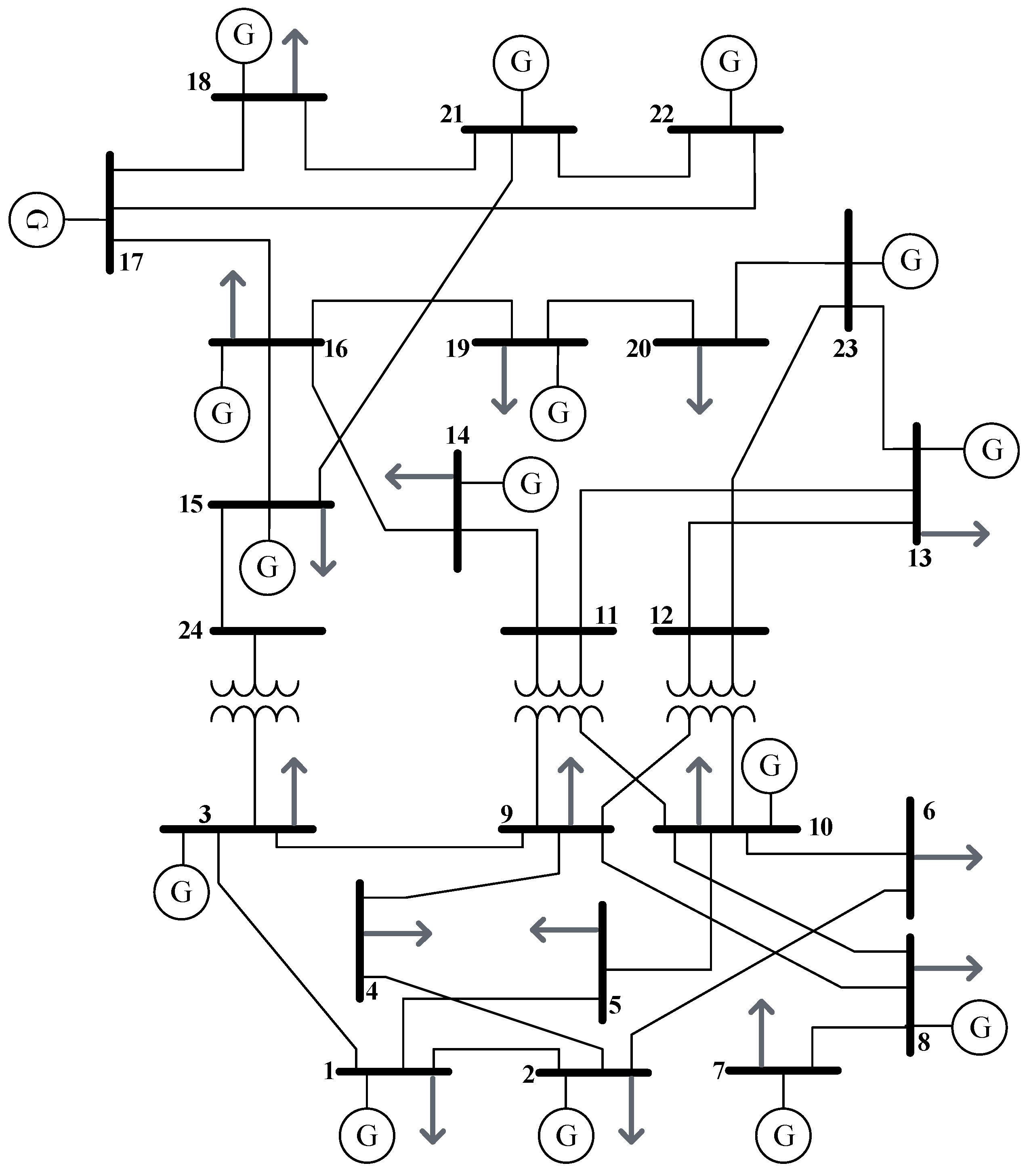
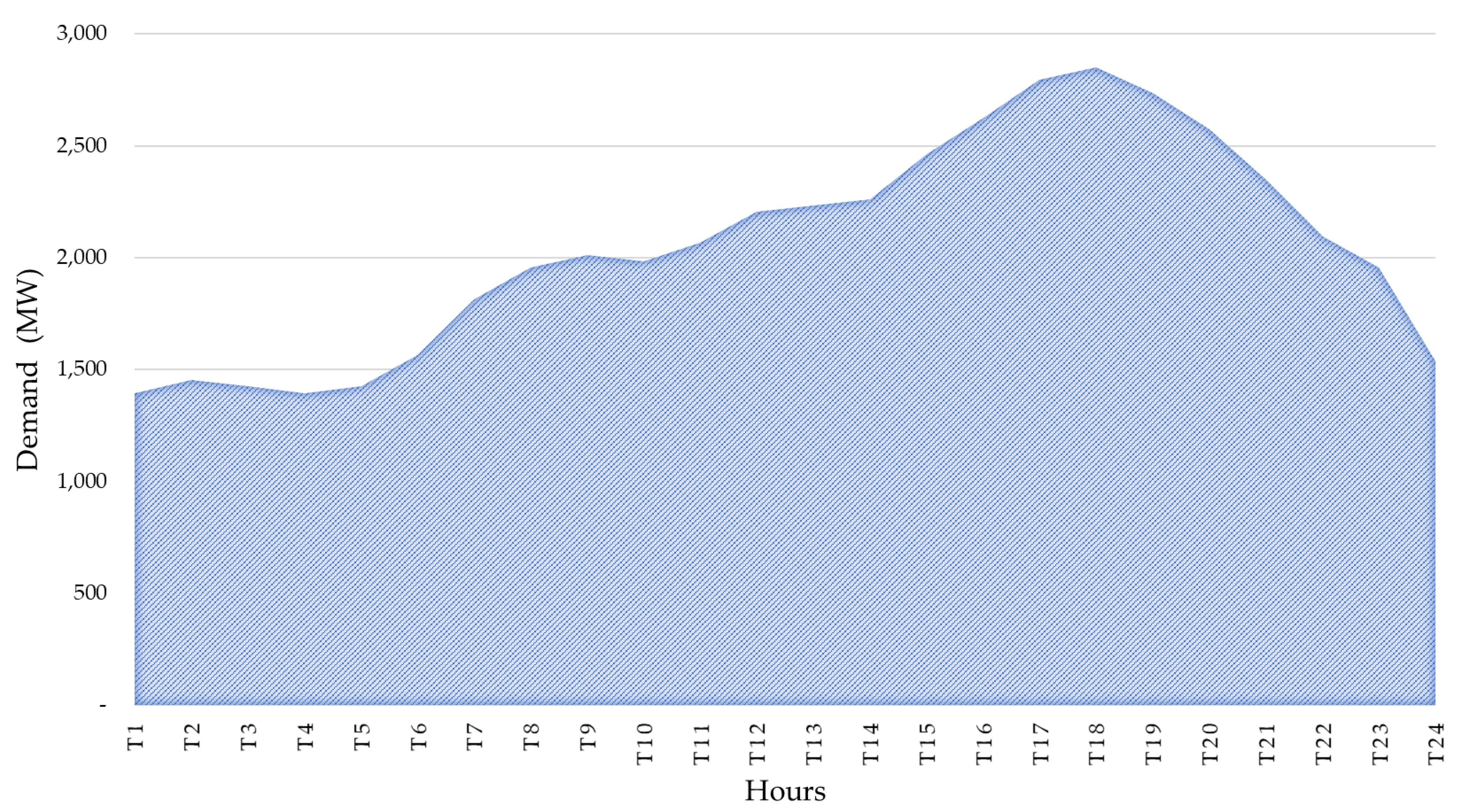
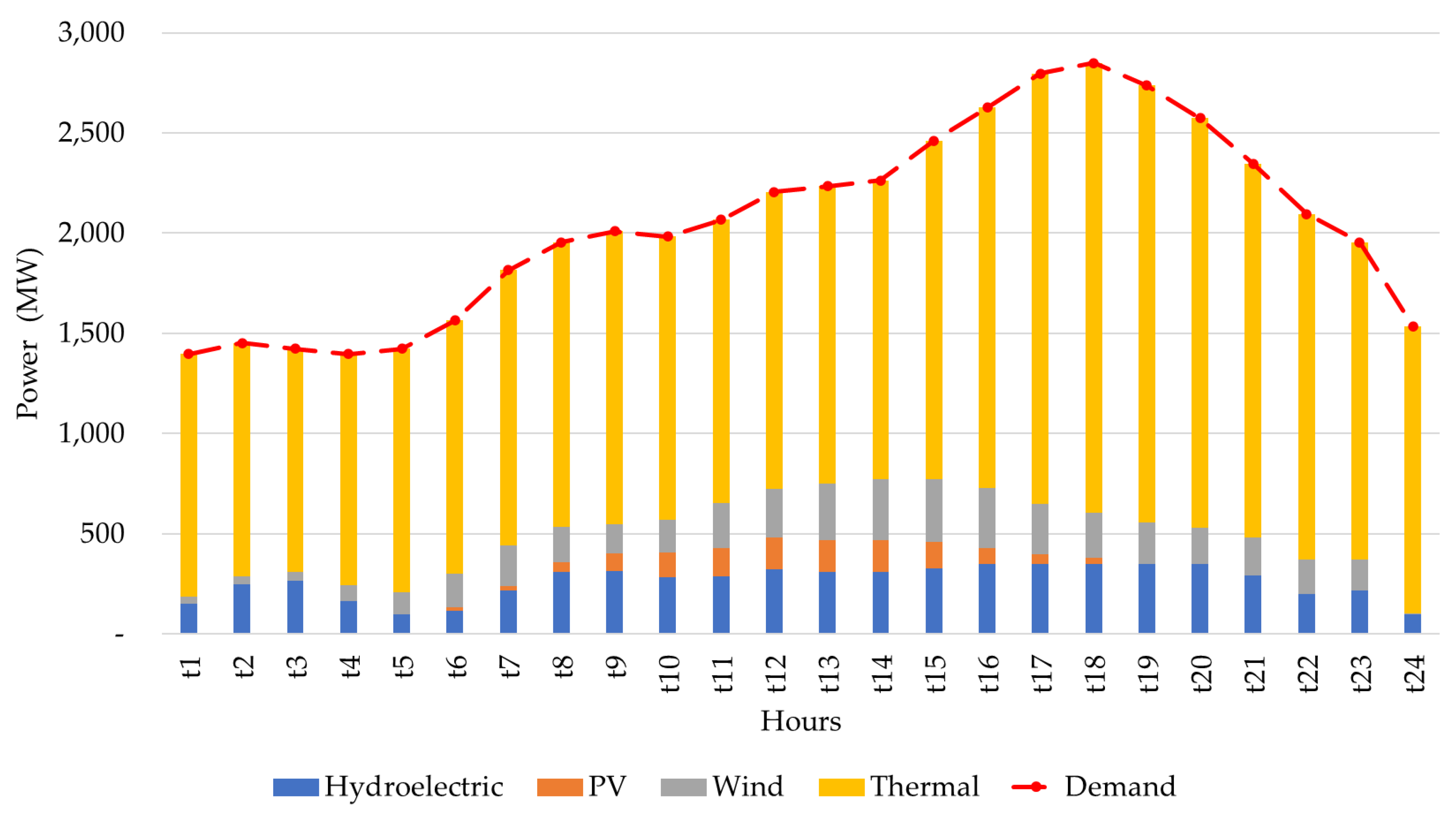
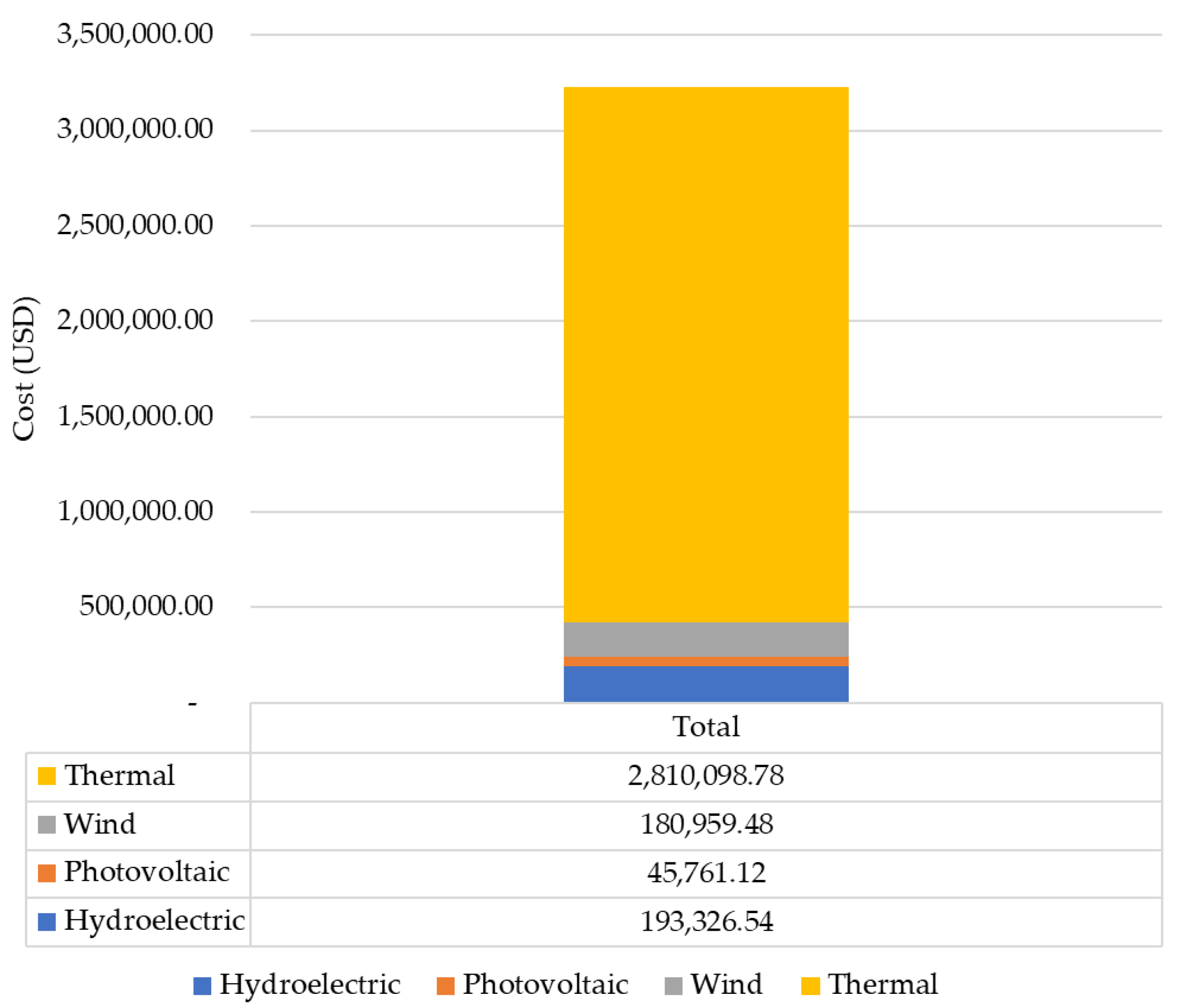
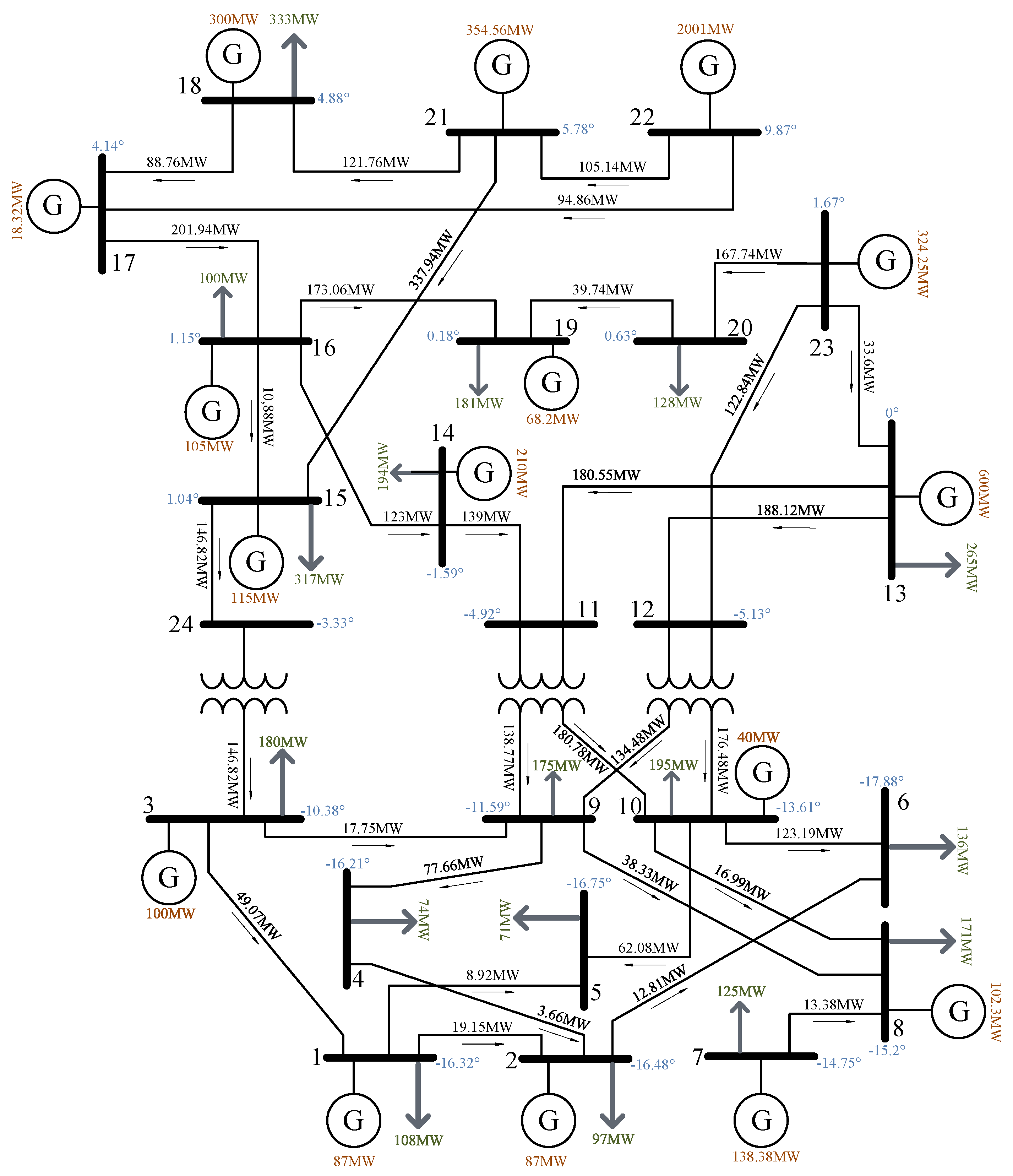
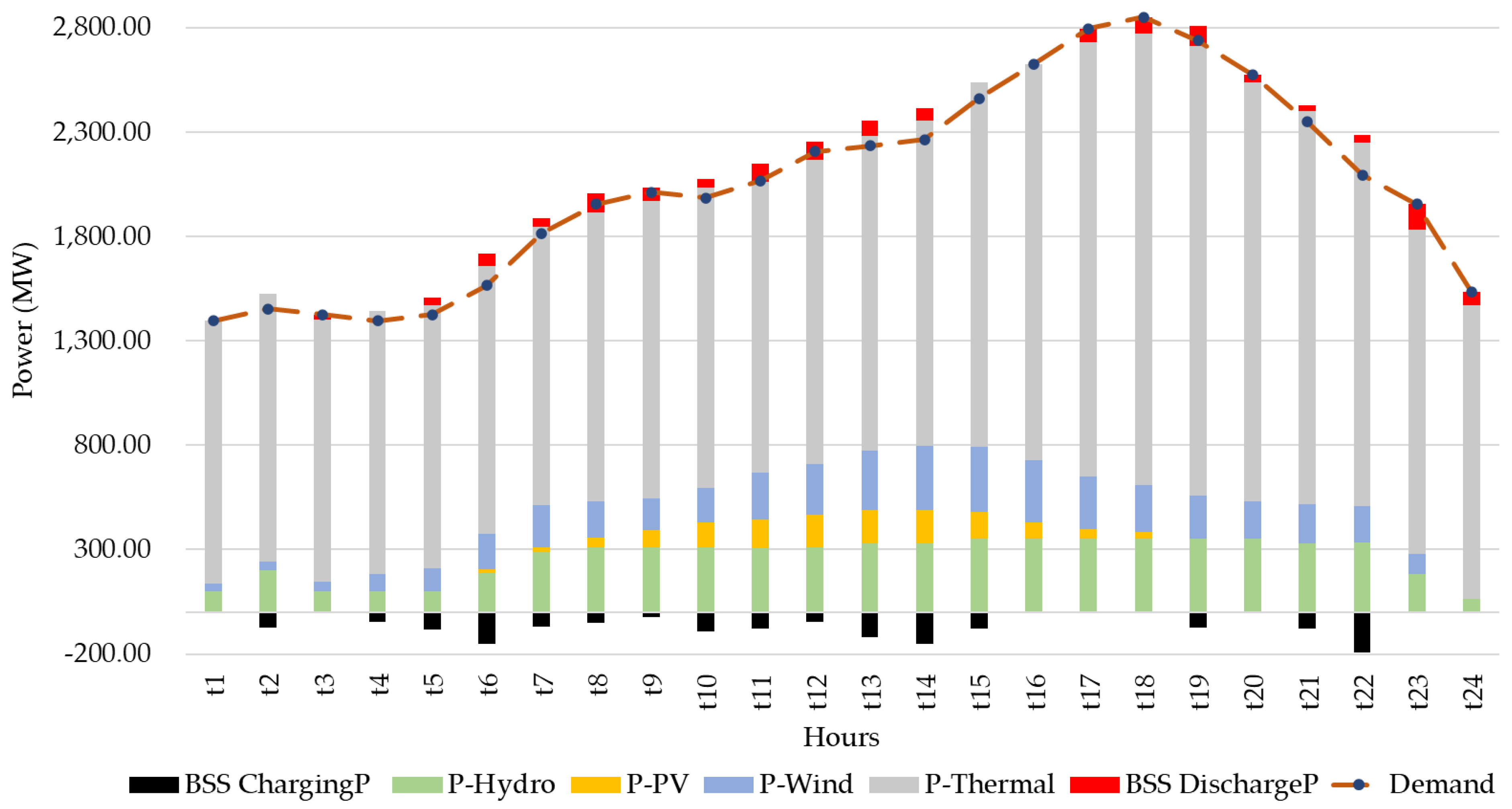

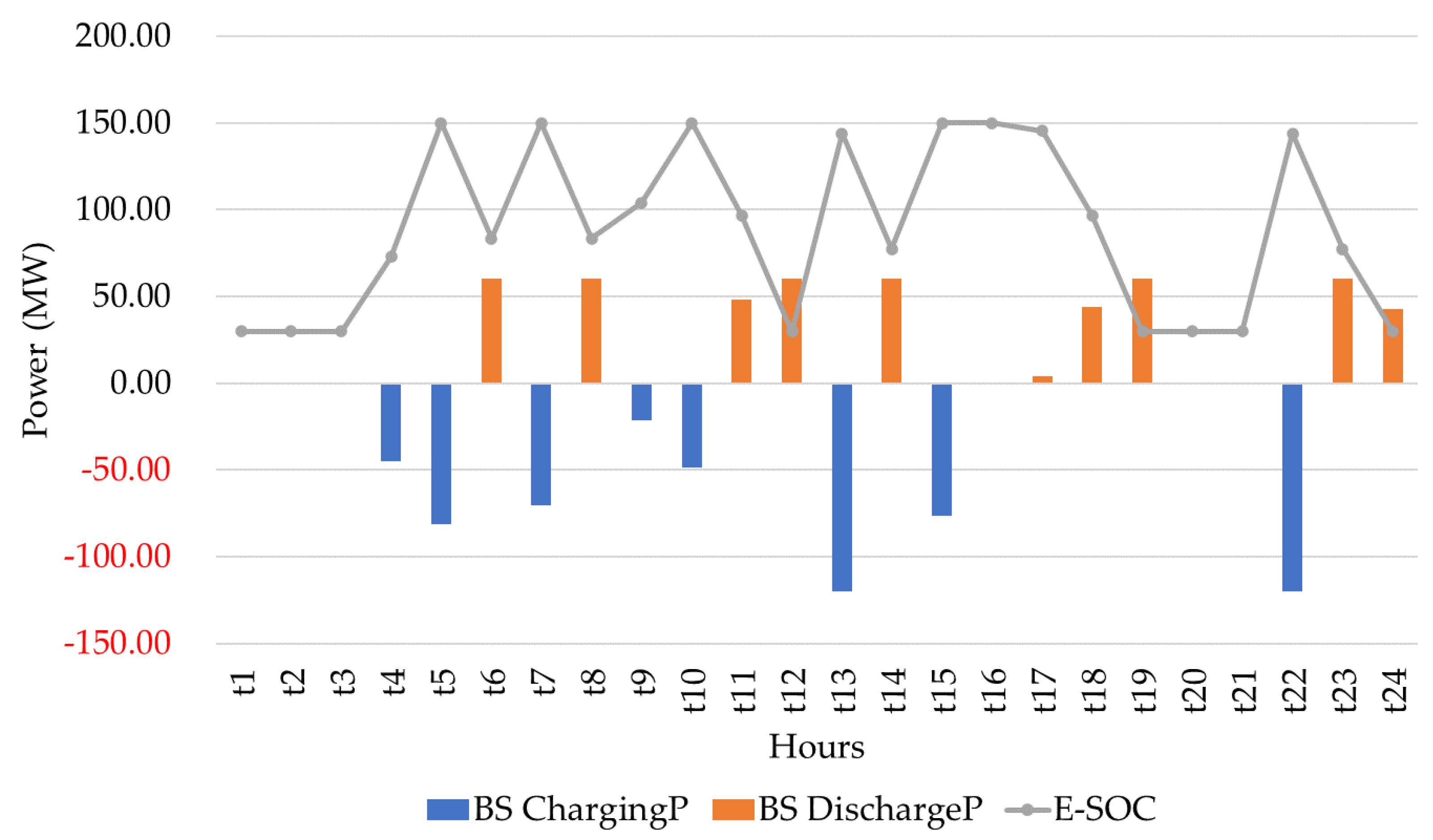
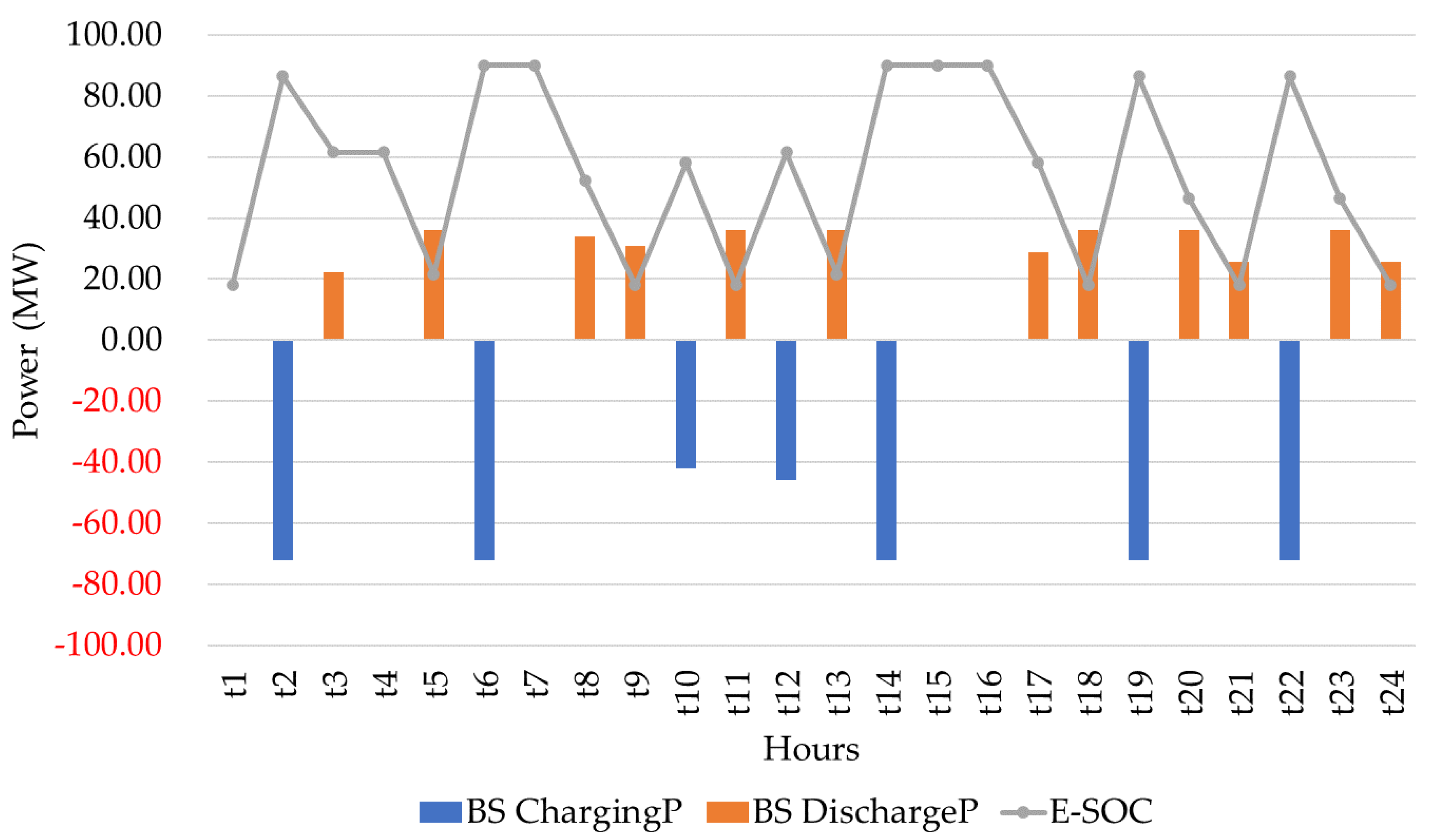

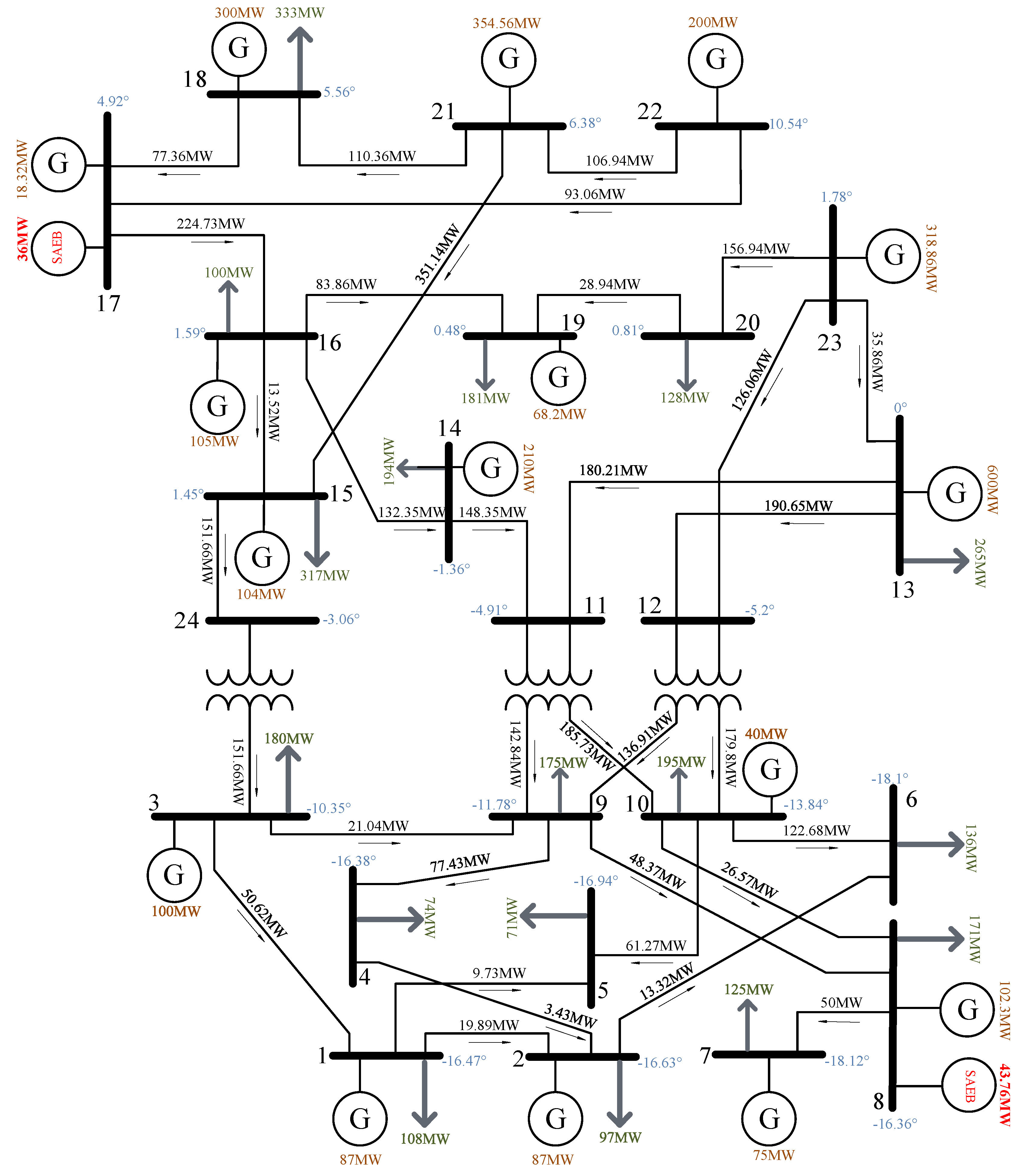
| Optimal placement of storage systems using DC power flows. | |
| Step 1: | Absorption of technical data of the power system |
| Step 2 | Establishment of the components associated with the generation and transportation networks, as well as the factors related to the potential storage systems to be incorporated
|
| Step 3 | Determination of variables Continuous: |
| Step 4 | Optimization model formulation FO Minimize total operating costs, including the fees of energy that is not supplied to demand. Restrictions
|
| Step 5 | Implementation and solution of case studies |
| Step 6 | Studies of the responses were obtained. |
| Step 7 | End |
| Type | Bus | (MW) | (MW) | (MWh) | (MWh) | ($/MWh) | |
|---|---|---|---|---|---|---|---|
| u1 | T | 18 | 300 | 100 | 120 | 66.63 | 55.341 |
| u2 | T | 21 | 300 | 100 | 65 | 36.12 | 56.321 |
| u3 | T | 1 | 122 | 31 | 36 | 20.00 | 127.714 |
| u4 | T | 2 | 122 | 31 | 65 | 36.18 | 127.714 |
| u5 | T | 15 | 105 | 52 | 50 | 27.76 | 156.800 |
| u6 | T | 16 | 105 | 32 | 65 | 36.12 | 98.510 |
| u7 | T | 23 | 110 | 20 | 45 | 25.01 | 98.510 |
| u8 | T | 23 | 200 | 10 | 32 | 12.00 | 98.872 |
| u9 | T | 7 | 200 | 75 | 45 | 14.00 | 196.686 |
| u10 | T | 13 | 600 | 120 | 18 | 26.99 | 49.911 |
| u11 | T | 15 | 60 | 10 | 32 | 47.96 | 254.908 |
| u12 | T | 22 | 200 | 0 | 32 | 48.10 | 73.500 |
| u13 | H | 14 | 210 | 0 | 32 | 8.00 | 35.280 |
| u14 | H | 3 | 100 | 0 | 32 | 44.12 | 22.540 |
| u15 | H | 10 | 40 | 0 | 32 | 48.00 | 41.160 |
| Type | Bus | (MW) | (MW) | (USD/MWh) |
|---|---|---|---|---|
| E1 | 8 | 150 | 0 | 43 |
| E2 | 19 | 100 | 0 | |
| E3 | 21 | 80 | 0 | |
| FV1 | 17 | 90 | 0 | 38 |
| FV2 | 23 | 70 | 0 |
| E | FV | E | FV | ||
|---|---|---|---|---|---|
| t1 | 10.2% | 0.0% | t13 | 85.5% | 100.0% |
| t2 | 12.2% | 0.0% | t14 | 92.6% | 99.7% |
| t3 | 13.2% | 0.0% | t15 | 94.6% | 81.4% |
| t4 | 24.4% | 0.0% | t16 | 90.5% | 50.9% |
| t5 | 33.6% | 0.0% | t17 | 76.3% | 30.5% |
| t6 | 50.9% | 10.2% | t18 | 68.2% | 20.3% |
| t7 | 61.0% | 14.2% | t19 | 63.1% | 0.0% |
| t8 | 52.9% | 30.3% | t20 | 54.9% | 0.0% |
| t9 | 44.8% | 53.6% | t21 | 57.0% | 0.0% |
| t10 | 48.8% | 76.3% | t22 | 52.9% | 0.0% |
| t11 | 68.2% | 86.5% | t23 | 45.8% | 0.0% |
| t12 | 73.3% | 98.7% | t24 | 32.6% | 0.0% |
| Bar | (MW) | Bar | (MW) |
|---|---|---|---|
| 1 | 108 | 13 | 265 |
| 2 | 97 | 14 | 194 |
| 3 | 180 | 15 | 317 |
| 4 | 74 | 16 | 100 |
| 5 | 71 | 17 | 0 |
| 6 | 136 | 18 | 333 |
| 7 | 125 | 19 | 181 |
| 8 | 171 | 20 | 128 |
| 9 | 175 | 21 | 0 |
| 10 | 195 | 22 | 0 |
| 11 | 0 | 23 | 0 |
| 12 | 0 | 24 | 0 |
| Bar i | Bar j | X (pu) | Limit (MWA) |
|---|---|---|---|
| 1 | 2 | 0.0139 | 175 |
| 1 | 3 | 0.2112 | 175 |
| 1 | 5 | 0.0845 | 175 |
| 2 | 4 | 0.1267 | 175 |
| 2 | 6 | 0.192 | 175 |
| 3 | 9 | 0.119 | 175 |
| 3 | 24 | 0.0839 | 400 |
| 4 | 9 | 0.1037 | 175 |
| 5 | 10 | 0.0883 | 175 |
| 6 | 10 | 0.0605 | 175 |
| 7 | 8 | 0.0614 | 175 |
| 8 | 9 | 0.1651 | 175 |
| 8 | 10 | 0.1651 | 175 |
| 9 | 11 | 0.0839 | 400 |
| 9 | 12 | 0.0839 | 400 |
| 10 | 11 | 0.0839 | 400 |
| 10 | 12 | 0.0839 | 400 |
| 11 | 13 | 0.0476 | 500 |
| 11 | 14 | 0.0418 | 500 |
| 12 | 13 | 0.0476 | 500 |
| 12 | 23 | 0.0966 | 500 |
| 13 | 23 | 0.0865 | 500 |
| 14 | 16 | 0.0389 | 500 |
| 15 | 16 | 0.0173 | 500 |
| 15 | 21 | 0.0245 | 1000 |
| 15 | 24 | 0.0519 | 500 |
| 16 | 17 | 0.0259 | 500 |
| 16 | 19 | 0.0231 | 500 |
| 17 | 18 | 0.0144 | 500 |
| 17 | 22 | 0.1053 | 500 |
| 18 | 21 | 0.013 | 1000 |
| 19 | 20 | 0.0198 | 1000 |
| 20 | 23 | 0.0108 | 1000 |
| 21 | 22 | 0.0678 | 500 |
| h | (%) | h | (%) |
|---|---|---|---|
| t1 | 49.00 | t13 | 78.40 |
| t2 | 50.96 | t14 | 79.38 |
| t3 | 49.98 | t15 | 86.36 |
| t4 | 49.00 | t16 | 92.14 |
| t5 | 49.98 | t17 | 98.08 |
| t6 | 54.88 | t18 | 100.00 |
| t7 | 63.70 | t19 | 96.04 |
| t8 | 68.60 | t20 | 90.28 |
| t9 | 70.56 | t21 | 82.36 |
| t10 | 69.58 | t22 | 73.50 |
| t11 | 72.52 | t23 | 68.60 |
| t12 | 77.42 | t24 | 53.90 |
| Bar | ||
|---|---|---|
| BESS 1 | 19 | 100 |
| BESS 2 | 21 | 80 |
| BESS 3 | 8 | 150 |
| BESS 4 | 17 | 90 |
| BESS 5 | 23 | 70 |
| 20% | |
| 95% | |
| 90% |
| Technology | Bar | Energy (MWH) | Total (MWH) | Cost (USD) | Total (USD) |
|---|---|---|---|---|---|
| Hydro | bar 3 | 2400.00 | 6300.00 | 54,096.00 | 193,326.54 |
| bar 10 | 278.66 | 11,469.81 | |||
| bar 14 | 3621.34 | 127,760.7 | |||
| FV | bar 17 | 677.39 | 1204.24 | 25,740.63 | 45,761.12 |
| bar 23 | 526.86 | 20,020.49 | |||
| Wind | bar 8 | 1912.35 | 4208.36 | 82,231.05 | 180,959.48 |
| bar 19 | 1274.90 | 54,820.70 | |||
| bar 21 | 1021.11 | 43,907.73 | |||
| Thermal | bar 1 | 968.00 | 37,456.17 | 123,627.1 | 2,810,098.78 |
| bar 2 | 968.00 | 123,627.1 | |||
| bar 7 | 1961.10 | 385,720.9 | |||
| bar 13 | 14,361.5 | 716,795.4 | |||
| bar 15 | 1647.00 | 281,795.5 | |||
| bar 16 | 1204.63 | 118,668.3 | |||
| bar 18 | 6578.02 | 364,034.2 | |||
| bar 21 | 5285.95 | 297,709.8 | |||
| bar 22 | 1760.00 | 129,360.0 | |||
| bar 23 | 2722.00 | 268,760.3 | |||
| Total | 49,168.77 | 3,230,145.9 | |||
| Technology | Bar | Power (MW) | Total (MW) |
|---|---|---|---|
| Hydro | bar 3 | 100.00 | 350.00 |
| bar 10 | 40.00 | ||
| bar 14 | 210.00 | ||
| FV | bar 17 | 18.32 | 32.56 |
| bar 23 | 14.25 | ||
| Wind | bar 8 | 102.30 | 225.06 |
| bar 19 | 68.20 | ||
| bar 21 | 54.56 | ||
| Thermal | bar 1 | 87.00 | 2242.38 |
| bar 2 | 87.00 | ||
| bar 7 | 138.38 | ||
| bar 13 | 600.00 | ||
| bar 15 | 115.00 | ||
| bar 16 | 105.00 | ||
| bar 18 | 300.00 | ||
| bar 21 | 300.00 | ||
| bar 22 | 200.00 | ||
| bar 23 | 310.00 | ||
| Total | 2850.00 | ||
| Bar | Flow (MW) | Bar | Flow (MW) | ||
|---|---|---|---|---|---|
| I | j | I | j | ||
| 1 | 2 | 19.15 | 13 | 12 | 188.12 |
| 1 | 5 | 8.92 | 14 | 11 | 139.00 |
| 2 | 6 | 12.81 | 15 | 24 | 146.82 |
| 3 | 1 | 49.07 | 16 | 14 | 123.00 |
| 3 | 9 | 17.75 | 16 | 15 | 10.88 |
| 4 | 2 | 3.66 | 16 | 19 | 73.06 |
| 7 | 8 | 13.38 | 17 | 16 | 201.94 |
| 9 | 4 | 77.66 | 18 | 17 | 88.76 |
| 9 | 8 | 38.33 | 20 | 19 | 39.74 |
| 10 | 5 | 62.08 | 21 | 15 | 337.94 |
| 10 | 6 | 123.19 | 21 | 18 | 121.76 |
| 10 | 8 | 16.99 | 22 | 17 | 94.86 |
| 11 | 9 | 138.77 | 22 | 21 | 105.14 |
| 11 | 10 | 180.78 | 23 | 12 | 122.84 |
| 12 | 9 | 134.48 | 23 | 13 | 33.66 |
| 12 | 10 | 176.48 | 23 | 20 | 167.74 |
| 13 | 11 | 180.55 | 24 | 3 | 146.82 |
| Bar | Optimal BESS |
|---|---|
| 8 | √ |
| 17 | √ |
| 19 | √ |
| Technology | Bar | Energy (MWH) | Total (MWH) | Cost (USD) | Total (USD) |
|---|---|---|---|---|---|
| BESS charge | bar 8 | −583.16 | −1402.15 | −127,097.1 | −305,593.91 |
| bar 17 | −448.00 | −97,639.96 | |||
| bar 19 | −370.99 | −80,856.82 | |||
| BESS discharge | bar 8 | 498.60 | 1198.84 | 13,144.38 | 31,604.51 |
| bar 17 | 383.04 | 10,097.92 | |||
| bar 19 | 317.20 | 8362.21 | |||
| Hydro | bar 3 | 2331.33 | 6300.00 | 52,548.18 | 194,611.58 |
| bar 10 | 348.42 | 14,341.05 | |||
| bar 14 | 3620.25 | 127,722.3 | |||
| FV | bar 17 | 677.39 | 1204.24 | 25,740.63 | 45,761.12 |
| bar 23 | 526.86 | 20,020.49 | |||
| Wind | bar 8 | 1912.35 | 4151.61 | 82,231.05 | 178,519.23 |
| bar 19 | 1255.98 | 54,007.14 | |||
| bar 21 | 983.28 | 42,281.04 | |||
| Thermal | bar 1 | 968.00 | 37,716.23 | 123,627.1 | 2,796,531.85 |
| bar 2 | 968.00 | 123,627.1 | |||
| bar 7 | 1837.10 | 361,331.8 | |||
| bar 13 | 14,337.0 | 715,574.0 | |||
| bar 15 | 1614.00 | 276,621.1 | |||
| bar 16 | 1206.00 | 118,803.1 | |||
| bar 18 | 7049.85 | 390,145.9 | |||
| bar 21 | 5388.30 | 303,474.5 | |||
| bar 22 | 1820.79 | 133,827.7 | |||
| bar 23 | 2527.19 | 249,499.4 | |||
| Total | 49,168.77 | 2,941,434.38 | |||
| Technology | Bar | Power (MW) | Total (MW) |
|---|---|---|---|
| BESS Charge | bar 8 | 43.76 | 79.76 |
| bar 17 | 36.00 | ||
| Hydro | bar 3 | 100.00 | 350.00 |
| bar 10 | 40.00 | ||
| bar 14 | 210.00 | ||
| FV | bar 17 | 18.32 | 32.56 |
| bar 23 | 14.25 | ||
| Wind | bar 8 | 102.30 | 225.06 |
| bar 19 | 68.20 | ||
| bar 21 | 54.56 | ||
| Thermal | bar 1 | 87.00 | 2162.62 |
| bar 2 | 87.00 | ||
| bar 7 | 75.00 | ||
| bar 13 | 600.00 | ||
| bar 15 | 104.00 | ||
| bar 16 | 105.00 | ||
| bar 18 | 300.00 | ||
| bar 21 | 300.00 | ||
| bar 22 | 200.00 | ||
| bar 23 | 304.62 | ||
| Total | 2850.00 | ||
| Bar | Flow (MW) | Bar | Flow (MW) | ||
|---|---|---|---|---|---|
| i | j | i | j | ||
| 1 | 2 | 19.89 | 13 | 12 | 190.65 |
| 1 | 5 | 9.73 | 14 | 11 | 148.35 |
| 2 | 6 | 13.32 | 15 | 24 | 151.66 |
| 3 | 1 | 50.62 | 16 | 14 | 132.35 |
| 3 | 9 | 21.04 | 16 | 15 | 13.52 |
| 4 | 2 | 3.43 | 16 | 19 | 83.86 |
| 7 | 8 | 50.00 | 17 | 16 | 224.73 |
| 9 | 4 | 77.43 | 18 | 17 | 77.36 |
| 9 | 8 | 48.37 | 20 | 19 | 28.94 |
| 10 | 5 | 61.27 | 21 | 15 | 351.14 |
| 10 | 6 | 122.68 | 21 | 18 | 110.36 |
| 10 | 8 | 26.57 | 22 | 17 | 93.06 |
| 11 | 9 | 142.84 | 22 | 21 | 106.94 |
| 11 | 10 | 185.73 | 23 | 12 | 126.06 |
| 12 | 9 | 136.91 | 23 | 13 | 35.86 |
| 12 | 10 | 179.80 | 23 | 20 | 156.94 |
| 13 | 11 | 180.21 | 24 | 3 | 151.66 |
Disclaimer/Publisher’s Note: The statements, opinions and data contained in all publications are solely those of the individual author(s) and contributor(s) and not of MDPI and/or the editor(s). MDPI and/or the editor(s) disclaim responsibility for any injury to people or property resulting from any ideas, methods, instructions or products referred to in the content. |
© 2023 by the authors. Licensee MDPI, Basel, Switzerland. This article is an open access article distributed under the terms and conditions of the Creative Commons Attribution (CC BY) license (https://creativecommons.org/licenses/by/4.0/).
Share and Cite
Rengel, A.; Téllez, A.A.; Ortiz, L.; Ruiz, M. Optimal Insertion of Energy Storage Systems Considering the Economic Dispatch and the Minimization of Energy Not Supplied. Energies 2023, 16, 2593. https://doi.org/10.3390/en16062593
Rengel A, Téllez AA, Ortiz L, Ruiz M. Optimal Insertion of Energy Storage Systems Considering the Economic Dispatch and the Minimization of Energy Not Supplied. Energies. 2023; 16(6):2593. https://doi.org/10.3390/en16062593
Chicago/Turabian StyleRengel, Andrés, Alexander Aguila Téllez, Leony Ortiz, and Milton Ruiz. 2023. "Optimal Insertion of Energy Storage Systems Considering the Economic Dispatch and the Minimization of Energy Not Supplied" Energies 16, no. 6: 2593. https://doi.org/10.3390/en16062593









